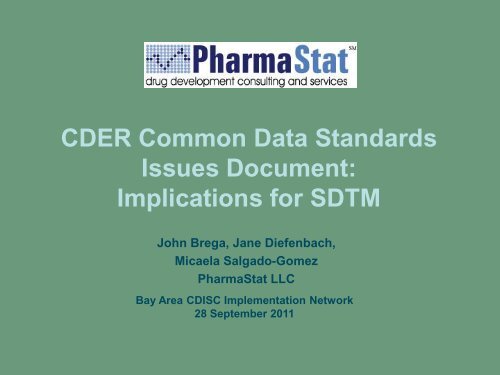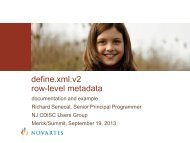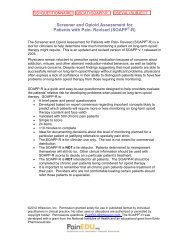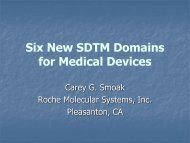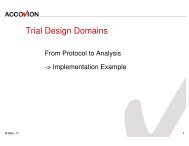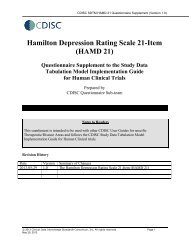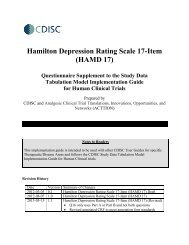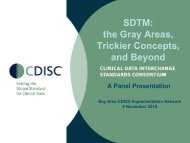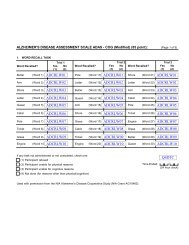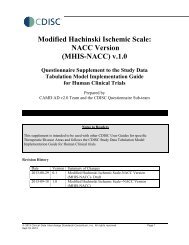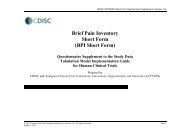Implications for SDTM
CDER Common Data Standards Issues Document ... - CDISC Portal
CDER Common Data Standards Issues Document ... - CDISC Portal
- No tags were found...
Create successful ePaper yourself
Turn your PDF publications into a flip-book with our unique Google optimized e-Paper software.
CDER Common Data Standards<br />
Issues Document:<br />
<strong>Implications</strong> <strong>for</strong> <strong>SDTM</strong><br />
John Brega, Jane Diefenbach,<br />
Micaela Salgado-Gomez<br />
PharmaStat LLC<br />
Bay Area CDISC Implementation Network<br />
28 September 2011
Disclaimers<br />
• The views expressed are those of the presenter<br />
and not necessarily of the FDA or CDISC<br />
• With the FDA, as with the stock market, past<br />
per<strong>for</strong>mance is no guarantee of future<br />
direction…<br />
• Nothing in this presentation should be taken as<br />
regulatory advice!<br />
2
The Documents<br />
• CDER published the CDER Common Data<br />
Standards Issues Document in May, 2011<br />
– Find the document by Googling its title. It is the first link.<br />
– I’ll call it the CCDSID because we love acronyms and need<br />
more of them.<br />
• At the same time, CDISC published Amendment 1<br />
to <strong>SDTM</strong> v1.2 and <strong>SDTM</strong> IG v3.1.2<br />
– These actions were coordinated. The CCDSID references<br />
Amendment 1, which supports CDER’s preferences<br />
– This document is temporarily not available on the CDISC<br />
website because the comment period has closed.<br />
3
The Highlights<br />
• CCDSID Contains advice on<br />
– <strong>SDTM</strong>, ADaM and SEND<br />
– Controlled terminologies, MedDRA and drug<br />
dictionaries<br />
– Use of variables and domains<br />
– Traceability and documentation<br />
• Amendment 1 contains<br />
– New variables <strong>for</strong> DM and the Events class domains<br />
– Instructions <strong>for</strong> their use<br />
4
CDER’s Rules of Thumb<br />
• Submit <strong>SDTM</strong><br />
• Document it with define.xml and define.pdf<br />
• If you submit <strong>SDTM</strong>, also submit ADSL<br />
• Derive ADaM datasets from the submitted <strong>SDTM</strong><br />
• Ensure traceability from CRF to <strong>SDTM</strong> to ADaM<br />
• Use CDISC controlled terminology<br />
• Use MedDRA as it comes from the dictionary, use a<br />
single version <strong>for</strong> the ISS, don’t include numeric<br />
codes<br />
• Don’t use Suppquals as a wastebasket<br />
5
The <strong>SDTM</strong> Specifics: AE<br />
• MedDRA terms other than SOC and preferred term<br />
were suppquals. Now they are variables.<br />
– Amendment 1 defines 10 new variables <strong>for</strong> MedDRA<br />
terms and codes<br />
• A Treatment Emergent Flag (--TRTEM) variable has<br />
been added. FDA wants us to use it.<br />
• These new variables can be used in any Events<br />
class domain with coded terms, such as MH<br />
(Medical History)<br />
• All are Expected, which contradicts the CCDSID<br />
6
New Events Variables<br />
Variable Name Variable Label Type<br />
Controlled Terms,<br />
Codelist or Format<br />
--TRTEM Treatment Emergent Flag Char (NY)<br />
--LLT Lowest Level Term Char MedDRA<br />
--LLTCD Lowest Level Term Code Num MedDRA<br />
--PTCD Preferred Term Code Num MedDRA<br />
--HLT High Level Term Char MedDRA<br />
--HLTCD High Level Term Code Num MedDRA<br />
--HLGT High Level Group Term Char MedDRA<br />
--HLGTCD High Level Group Term Code Num MedDRA<br />
--SOC Primary System Organ Class Char MedDRA<br />
--SOCCD Primary System Organ Class Code Num MedDRA<br />
--BDSYCD Body System Code Num MedDRA<br />
7
The <strong>SDTM</strong> Specifics: DM<br />
• 8 new variables are added:<br />
– Actual Arm and Arm Code<br />
– Dates of First and Last Study Treatment Exposure<br />
– Dates of In<strong>for</strong>med Consent and End of Participation<br />
– Date of Death and Subject Death Flag<br />
• Some may be redundant with RFSTDTC or<br />
RFENDTC<br />
• All are Required or Expected<br />
8
New DM Variables<br />
Variable Name Variable Label Type<br />
Controlled Terms,<br />
Codelist or Format<br />
ACTARMCD Actual Arm Code Char *<br />
ACTARM D Actual Arm Char *<br />
RFXSTDTC Date/Time of First Study Treatment Exposure Char ISO 8601<br />
RFXENDTC Date/Time of Last Study Treatment Exposure Char ISO 8601<br />
RFICDTC Date/Time of In<strong>for</strong>med Consent Char ISO 8601<br />
RFPENDTC Date/Time of End of Participation Char ISO 8601<br />
DTHDTC Date of Death Char ISO 8601<br />
DTHFL Subject Death Flag Char (NY)<br />
*Note that labels are too long <strong>for</strong> two of the variables…<br />
9
The <strong>SDTM</strong> Specifics: DS<br />
• Use EPOCH in DS to distinguish multiple<br />
disposition events<br />
• If DEATH occurs it’s the last record and has an<br />
EPOCH<br />
10
More <strong>SDTM</strong> Specifics<br />
• Include EPOCH, ELEMENT and ETCD in every<br />
“subject-level” dataset (e.g., AE, LB, CM, EX, VS…)<br />
• Split large datasets by --CAT, include both the<br />
split and the complete datasets<br />
– How big is “large”? Up to 400mb is OK, but ask your<br />
review division<br />
11
The Larger <strong>Implications</strong><br />
• Some new variables are very analysis-like, some<br />
old variables will be used in an analysis-like<br />
way, which may involve complex derivations that<br />
depend on other derivations.<br />
• For example,<br />
– Flagging Treatment Emergent AEs requires<br />
comparison to exposure data, which may in turn be<br />
derived from drug accountability data<br />
– Determining EPOCH may be difficult if defined by<br />
events rather than visits, and involves date windowing<br />
<strong>for</strong> log data like AE and CM<br />
12
Questions to Ponder<br />
• Prior to these documents, a case could be made<br />
<strong>for</strong> using “pure” <strong>SDTM</strong> as an internal data<br />
standard. Is that still a valid strategy? If not,<br />
what should the new strategy be?<br />
• How will our processes need to change to<br />
support production of the new <strong>SDTM</strong>?<br />
14
Thank you!<br />
Questions?<br />
John Brega: JBrega@PharmaStat.com<br />
15


